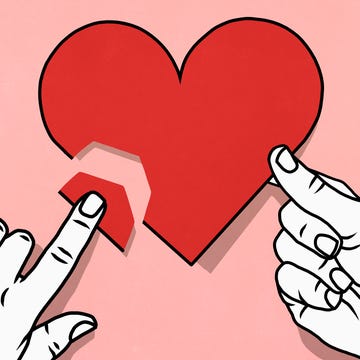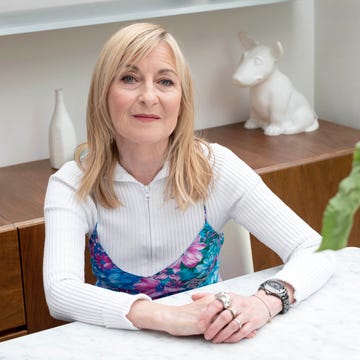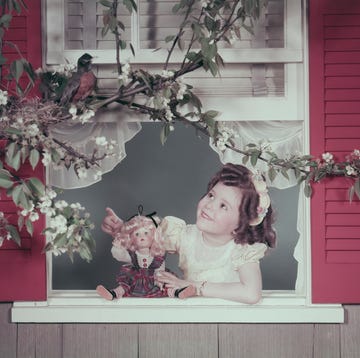Jump to:
- Is my hair loss normal?
- Do I just need to accept this as part of ageing?
- What is causing my hair to thin?
- Can stress trigger hair loss?
- How does the menopause affect hair loss?
- Could a vitamin deficiency be causing hair loss?
- What's the best diet for thinning hair
- Which hair regime tweaks are worth trying?
- Can light therapy help hair loss?
- What makes thinning hair worse?
Are you noticing more hair on your brush, a wider-looking parting, or that your ponytail feels thinner than it used to? You’re far from alone.
Because hair isn’t strictly essential to survival, it’s often the first casualty when energy is needed more urgently by your body elsewhere. The impact on your hair can be gradual or sudden, but either way it's understandably worrying and upsetting.
‘Hair cells are the second fastest growing cells the body produces, and their nutritional requirements are very high,' confirms Anabel Kingsley, trichologist at Philip Kingsley. Add in the impact of contributing factors such as genetics, hormones, stress, UV exposure, and general wear and tear, and you’ll see why hair growth can so easily falter.
What to read next
It’s not all follicular doom and gloom, however. Growth-stimulating treatments and products have become ever more sophisticated, and there’s also far more openness about hair loss and, crucially, what can really help. Here’s what you need to know about thinning hair from the causes to the most effective strategies to combat it.
Is my hair loss normal?
It’s normal to shed around 100 hairs a day, and you can expect a general decline in hair health with age. Hair density peaks at 27 and begins to thin from our mid-30s onwards. ‘Some women notice a marked difference in their 40s and 50s, whereas for others it’s more subtle,' says Anabel. 'The extent to which our hair changes is largely dependent on genes, but also on when we enter the menopause. Oestrogen has a very supportive role when it comes to skin, scalp and hair health, and as levels decline during the menopause, this can affect hair density.'
Do I just need to accept this as part of ageing?
Absolutely not. 'You should never think you need to put up with thinning hair just because you're getting older,' says trichologist Eva Proudman. If you notice more thinning or hair fall than you’re used to, Eva strongly advises seeing a professional. ‘I see women who have spent thousands on hair loss remedies, and nothing has worked. The reason it doesn’t work is because you need a diagnosis. When we know what’s wrong, we can tell you what we need to do.’
The changes can be ‘very simple’, from diet to lifestyle, she says, but if you rely on Google rather than an expert, you’re basing it on guesswork. See a specialist and you'll be getting tailored, safe advice and it needn’t be prohibitively expensive. ‘The average hair loss treatment from a clinician like me is about £1 a day maximum – and it can give you back your hair,’ says Eva.
What is causing my hair to thin?
Dozens of medical issues, from autoimmune conditions and hormonal imbalances to scalp infections and genetics, can cause hair loss and thinning, but androgenetic alopecia (or female pattern hair loss) is by far the most common. A quarter of women have it, and it tends to cause thinning around the crown and temples in particular.
It happens when a sensitivity to male hormones (androgens) causes follicles to shrink over time. 'The hair becomes thinner until eventually the follicle closes over altogether,' explains Dr Martin Wade, dermatologist at The London Skin and Hair Clinic.
Unfortunately, there’s no magic cure for androgenetic alopecia, though treatments can include using minoxidil lotion. Some people won’t respond to it but, for those who do, it can slow down hair loss.
HRT, which combats falling oestrogen levels during the menopause, can have a beneficial effect on this kind of hair loss, too. Some of the drugs used, however, such as tibolone, may contribute to hair fall, so you should discuss exactly what you’re taking with your doctor.
If hair loss starts in your teens, it’s considered to be genetic. 'In genetic cases, some of the smaller follicles can recover with anti-androgenetic drugs such as finasteride or spironolactone,' says Dr Wade.
When hair falls out in patches, it could be down to alopecia areata, an autoimmune condition that affects 2% of women. The condition causes hair follicles to be attacked by the body’s own immune system, fast forwarding hair to its shedding phase. 'It’s still largely a mystery as to why it strikes, although stress is a known trigger,' said Dr Wade. 'We can treat it with steroids [both topical and oral] and, in most cases, the hair grows back.' Immunosuppressive drugs can also be used.
Both underactive and overactive thyroid conditions can cause hair loss as well. Blood tests, at the GP or under the supervision of a dermatologist or endocrinologist, can show your thyroid status, so that the relevant medication can be prescribed if necessary.
Bottom line: if your hair is thinning, it’s really worth getting professional advice and diagnostic testing.
Can stress trigger hair loss?
Yes, it really can, because hair is the first thing that the body deprioritises when we’re in crisis. Crash diets, illness, divorce or the loss of a loved one can lead to a form of widespread hair shedding called telogen effluvium.
Dr Wade explains: 'Stress shocks the hair prematurely out of the growth phase and into the resting phase.' You might notice less hair overall or wonder why your hair just won’t grow as long as it did. 'If the stress is acute, typically the shedding lasts for three months and then turns itself off,' Dr Wade says.
If stress is ongoing, then it’s another story. 'There is absolute association between chronic telogen effluvium and stress,' confirms Dr Justine Hextall of the Tarrant Street Clinic. 'Addressing the causes of your stress is imperative. Often, when we’re stressed we also don’t eat well, so looking at diet and supplements as well as whether you might be pulling at your hair due to stress can all help.'
Even the type of exercise you do can add to your stress load, so consider choosing yoga over HIIT if you feel the cortisol soaring.
How does the menopause affect hair loss?
It’s very common for hair to begin thinning around the perimenopause. ‘Our stored iron begins to deplete, which causes hair shedding,’ says Eva. She notes that GP blood tests for iron testing can be misleading, because the ‘normal’ range is very wide and your iron levels could still be impacting hair growth if they’re at the lower end of that spectrum. ‘We need a minimum of 70-80 mcg/dL for our hair,’ says Eva.
As mentioned, falling oestrogen levels can also affect hair growth. Our adrenal glands step in to produce sex hormones as the ovaries ‘retire’, so adrenal support is very important at this life stage, says nutritional therapist Eve Kalinik. 'Our over-worked adrenals can causes a knock-on effect on hormonal balance, which can manifest as hair loss or thinning,' she explains.
Supporting the adrenal glands with anti-inflammatory healthy fats, B vitamins and antioxidant vitamins (A, C, E) is vital to make us more stress resilient, Eve advises.
Could a vitamin deficiency be causing hair loss?
A lack of zinc, iron, biotin and vitamins B12 and D can all cause hair shedding to accelerate. ‘Ideally, you’d have a blood test and base any supplements on the results,’ explains Anabel. The Philip Kingsley clinic offers this service, alongside nutritional support.
If you’re unable to see a specialist, a good multivitamin supplement can boost hair growth where there’s a deficiency. 'Supplements can be handy as they give your hair extra internal support,' says Anabel. 'In instances where hair loss is being caused by a vitamin or mineral deficiency, they can make a world of difference.'
However, Anabel warns against over-supplementing, especially when it’s based on guesswork rather than blood work. 'For example, taking too much vitamin A can actually cause hair loss,' she explains.
In the latest Good Housekeeping Institute testing on growth-boosting supplements, New Nordic was a top-rated product – find our full guide to recommended hair growth supplements here.
What's the best diet for thinning hair
There are some nutrition basics when it comes to hair health. Eva says: ‘Our hair is made up of protein, so it's essential we eat enough. Essential amino acids from protein help the hair to stay in the growing phase for longer, so you keep more hair on your head for longer. They make the actual protein fibre thicker, too, and balance the scalp, which is crucial for optimal hair growth.’
Check your intake, she says. 'As an adult female, you need about 50 to 55 grams of protein a day – but if you add up what you actually consume, most people get about 30 grams.’
To help you get enough, Eve Kalinik says: 'Make sure you get a serving with every meal, using your palm as a measure of the amount you need.'
Good sources of protein include meat, eggs, and fish. Omega 3 fats found in oily fish are especially beneficial for nourishing follicles. Good vegetarian sources of omega 3s include flax, chia, walnuts and omega-enriched eggs.
Vegans should soak pulses, legumes and grains before cooking to gain the maximum protein and iron from them.
If you find it difficult to get enough protein, consider using one of the best protein supplement. Not all can be pleasant tasting, but we've found that More Protein's makes a genuinely delicious chocolate smoothie.
Eva recommends Absolute Collagen to support protein (each sachet is is the equivalent an egg) and for boosting general hair growth. Double blind placebo trials showed a 27% increase in hair stand count after 12 weeks. 'It reduces the speed of the shedding, so you have more hair on the head, and it feels and looks thicker.'
In terms of other dietary adjustments, sufficient iron is vital to nourish healthy hair. Good sources include red meat, full-fat dairy, eggs and lentils.
Eating regularly is key, too. 'Don't skip breakfast – your hair is starving,' says Eva. And beware extreme diets to deal with midlife weight gain: 'If you drop weight quickly, the follicle becomes lax and you’ll shed the hair.'
Which hair regime tweaks are worth trying?
To supplement general lifestyle changes, the GH beauty team recommends adding growth-stimulating drops to your hair regime. New names to note include TypeBea Overnight Boosting Peptide, which promises to reduce hair loss by 60%. GH favourite Living Proof has also introduced a Scalp Care Density Serum, which promise to increase density and reduce grey hair growth if used daily for 90 days. For best results, all drops require regular use.
Massage daily to maximise hair health. “The amount of extra hair growth that comes from a daily head massage is amazing,” says Zoë Irwin, creative director at John Frieda Salons. One study shows that massaging the head for between 11 and 20 minutes a day improves regrowth. “This is because massage stimulates blood flow, which has a great effect on scalp and therefore hair health. I’d recommend doing at least 10 minutes a day,” adds Zoë.
Don’t underestimate the power of brushing your hair, either. “Brushing for two minutes twice a day with a fine bristle brush distributes the scalp’s protective oils more evenly and over more of the hair’s length,” says Zoë.
Investing in the best thickening products can create a plumped up look to hair, and using an invisible hair thickening piece is also a great instant cheat with zero heat damage. GH beauty director Lynne is a huge fan of the Nothing2See hair halo.
Can light therapy help hair loss?
Red light therapy is backed by studies to show its benefits for hair and scalp, explains hair expert and Current Body ambassador Tom Smith. ‘Red light in general has been shown to be anti-inflammatory and rejuvenating for the skin on a cellular level, so therefore, there's lots of evidence that light therapy is going to help the scalp and hair.
The GHI recently tested CurrentBody’s LED Hair Regrowth Helmet in the lab, and found it made a marked difference to the thickness and volume of panellists’ hair by the end of the 16-week trial. While it’s important to note that it’s not intended to treat medical conditions such as alopecia or male/female pattern baldness, it impressed the GHI’s panel of testers who were experiencing thinning. Read the full review here.
Our findings are backed by Tom’s personal experience: ‘I have seen direct results on various clients who have been using it regularly.’ However you do need to commit to using it properly. ‘Hair growth is a slow and gradual process, so daily use is required for it to really work. Long term results can be seen around the 16 weeks mark. You'll notice that the hair is growing healthier and thicker.’
What makes thinning hair worse?
Experts agree that hot styling tools aren't great for fragile, thinning hair, so reduce the heat on your hairdryer and hot tools, and cut down your use where you can (these short haircuts for thin hair might make it easier to style without heat).
Older hairdryers or those that have been used a lot are less likely to have good temperature control, too; if it’s too hot for your scalp, it’s too hot for your hair. Investing in the best best hairdryer will help protect your hair and minimise styling time.
Using the right shampoo can really too help, as shown by the results of the best hair loss shampoos tested by the GHI.
Swapping rough pillowcases for silk pillowcases can also reduce damage and breakage.
You could also try a silk hair wrap and, if you tie your hair back, using silk hair ties or scrunchies will both minimise damage and lessen tension at the hairline, where many of us notice thinning the most. Try not to fiddle with your hair too much; the extra tension can weaken strands further.
As for styling, have some fun. 'I would recommend opting for a messier, more textured look, if possible,' says Suzie McGill, an ambassador for Schwarzkopf UK. 'Adding texture and volume when styling can disguise fine hair, whereas if you wear it smooth and sleek, your hair will appear thinner.'
Finally, don’t hide from your hairdresser. Stylists and colourists have seen it all, and a trim can make thinning hair look thicker, adding swish and definition. For colour, scale back damaging bleach and keep shades multidimensional. 'Block colour can make hair look thin,' says Jack Howard, a L’Oréal Professionnel UK colour spokesperson. Instead, it’s all about adding depth. 'Blondes can add dimension to their colour with multitonal shades, and brunettes can go for a few darker pieces to add the illusion of thicker hair.'




























